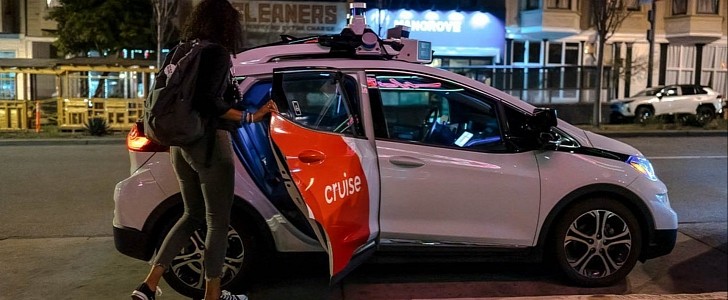GM subsidiary Cruise is one of the many companies trying to develop the concept of automated driving. The company has gotten a step closer to its objectives after receiving the first California permit to charge for self-driving car rides in San Francisco.
Truly driverless cars are yet to become a reality, despite bold statements from the car industry gurus. A breakthrough in this area is just around the corner, or everybody believes so. Personal vehicles still need to overcome many problems on the road to automated driving. One of them is the price of such a feature, which forces a difficult choice. The carmaker either settles for cheaper, more rudimentary equipment that could prove less safe in certain conditions or significantly raises the car’s price.
On the other hand, ridesharing companies like Waymo and Cruise can afford to offer more advanced driverless cars, at least in terms of hardware equipment and sensors. That’s because they don’t sell them but share them with the public. The ridesharing service is not even the final product, so it does not matter whether they have more or fewer paying customers. What matters to them is to have the cars on the roads, allowing the engineers to gather lots of driving data. This, in turn, helps with refining self-driving technology.
But to have all those cars on the roads, self-driving companies like GM’s Cruise need to overcome some legal hurdles. The main one is, of course, being allowed to operate driverless cars on public roads. Cruise has already got a permit for that and was able to start a limited service in San Francisco in February. However, it wasn’t allowed to charge paying customers for the service, and the operating conditions were pretty limited.
Now, Cruise has finally received a California permit, which allows it to charge customers for self-driving rides in San Francisco. The first of this kind, the permit was the last hurdle for GM subsidiary in California. Based on it, Cruise will launch paid services within the next couple of weeks, using 30 driverless Chevrolet Bolt electric vehicles. Some limitations are still in place, but those are more relaxed than before.
For instance, the cars are allowed to operate between 10 pm and 6 am, an interval two hours longer than before. All city areas except downtown are now open for business, even though the cars are not allowed to operate on highways or at times of heavy fog, precipitation, or smoke. The vehicles would also be limited to a maximum speed of 30 mph (48 kph).
The road to self-driving was not easy and is far from over. City officials have expressed concerns and have recommended requiring further approval to add more driverless cars on the road. Accidents have happened in the past. According to Reuters, Cruise vehicles suffered 34 accidents involving bodily harm or over $1,000 in damage across nearly 3 million miles of driving during a four-year span that ended May 2021.
On the other hand, ridesharing companies like Waymo and Cruise can afford to offer more advanced driverless cars, at least in terms of hardware equipment and sensors. That’s because they don’t sell them but share them with the public. The ridesharing service is not even the final product, so it does not matter whether they have more or fewer paying customers. What matters to them is to have the cars on the roads, allowing the engineers to gather lots of driving data. This, in turn, helps with refining self-driving technology.
But to have all those cars on the roads, self-driving companies like GM’s Cruise need to overcome some legal hurdles. The main one is, of course, being allowed to operate driverless cars on public roads. Cruise has already got a permit for that and was able to start a limited service in San Francisco in February. However, it wasn’t allowed to charge paying customers for the service, and the operating conditions were pretty limited.
Now, Cruise has finally received a California permit, which allows it to charge customers for self-driving rides in San Francisco. The first of this kind, the permit was the last hurdle for GM subsidiary in California. Based on it, Cruise will launch paid services within the next couple of weeks, using 30 driverless Chevrolet Bolt electric vehicles. Some limitations are still in place, but those are more relaxed than before.
For instance, the cars are allowed to operate between 10 pm and 6 am, an interval two hours longer than before. All city areas except downtown are now open for business, even though the cars are not allowed to operate on highways or at times of heavy fog, precipitation, or smoke. The vehicles would also be limited to a maximum speed of 30 mph (48 kph).
The road to self-driving was not easy and is far from over. City officials have expressed concerns and have recommended requiring further approval to add more driverless cars on the road. Accidents have happened in the past. According to Reuters, Cruise vehicles suffered 34 accidents involving bodily harm or over $1,000 in damage across nearly 3 million miles of driving during a four-year span that ended May 2021.














